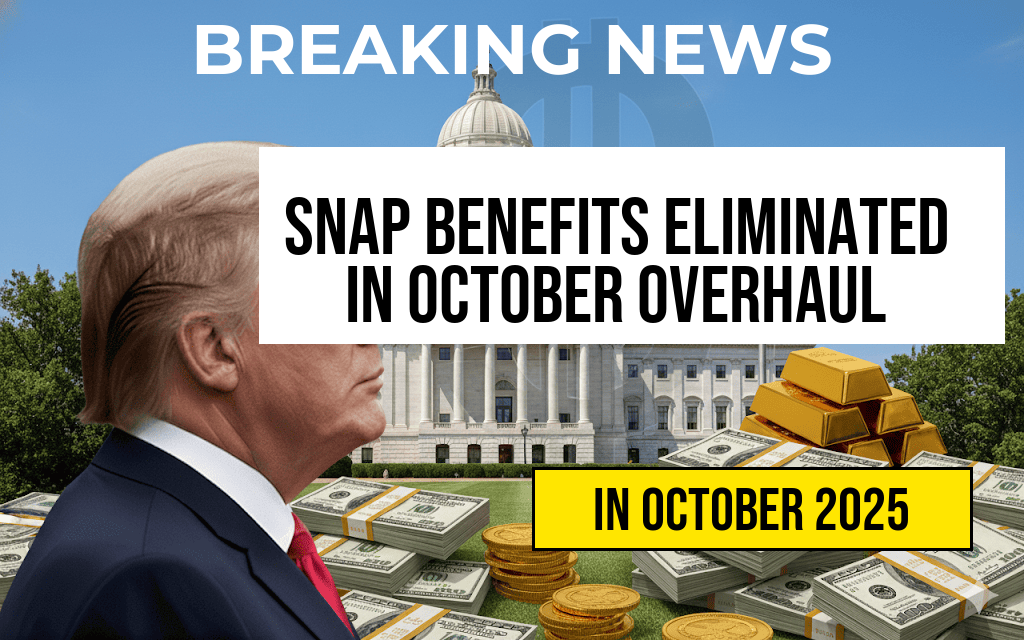The Supplemental Nutrition Assistance Program (SNAP), commonly known as food stamps, is set to undergo a significant overhaul in October that will result in the elimination of benefits for many recipients. The change stems from a federal policy adjustment aimed at reducing federal expenditures and encouraging employment among recipients. Starting next month, thousands of SNAP households across the country will see their monthly benefits cut or, in some cases, completely discontinued. This move has sparked widespread concern among advocacy groups and recipients, who warn it could exacerbate food insecurity during an already challenging economic climate.
Overview of the SNAP Benefits Reduction
The upcoming policy change is rooted in a federal initiative to tighten eligibility and benefit distribution rules. Previously, SNAP benefits were primarily based on a household’s income and size, with some exemptions for certain populations. Under the new guidelines, the Department of Agriculture (USDA) has introduced stricter work requirements and asset tests, which will disqualify some individuals and families from receiving benefits or reduce the amount they are eligible to receive.
The reforms are part of a broader effort to promote self-sufficiency by incentivizing employment. However, critics argue that the timing is problematic given ongoing economic uncertainties, including inflation and rising food prices. The USDA indicates that the changes will only affect a subset of recipients who do not meet the new criteria, but advocacy groups warn that many low-income households may be caught in the net due to outdated or incomplete information about their circumstances.
Key Changes in Eligibility and Benefits
Stricter Work Requirements
- Recipients aged 18-49 without dependents will be required to work at least 20 hours per week or participate in approved training programs to maintain eligibility.
- Exemptions will be limited, and states will have the authority to enforce these rules more rigorously.
Asset and Income Limits
- Many households will face tighter asset limits, potentially disqualifying those with savings or property exceeding the threshold.
- Income thresholds are being adjusted downward, meaning fewer households will qualify based on income alone.
Impact on Recipients
| Parameter | Pre-October Policy | Post-October Policy |
|---|---|---|
| Average monthly benefit per household | $250 | Estimated $50-$100 reduction |
| Number of households affected | Approximately 42 million | Potentially tens of thousands to hundreds of thousands affected |
Government Rationale and Industry Response
Officials from the USDA emphasize that the reforms are designed to promote employment and reduce dependency on federal assistance programs. “Our goal is to support able-bodied adults in gaining independence through work and training,” said a USDA spokesperson. They also highlight that similar reforms have been implemented in various states with positive employment outcomes.
However, critics argue that the timing disregards economic challenges faced by many low-income Americans. “Implementing such stringent policies during a period of economic instability could push vulnerable populations further into food insecurity,” said a spokesperson for a leading food assistance advocacy group. Some experts also point out that the policy may disproportionately impact marginalized communities, including minorities and single-parent households.
Potential Consequences and Community Responses
Analysts warn that the benefit cuts could lead to increased food insecurity, higher demand at food banks, and greater financial strain on families already struggling to make ends meet. Several community organizations are mobilizing to provide additional support and advocate for temporary exemptions or phased implementation to mitigate adverse effects.
States are evaluating their readiness to enforce the new rules, with some planning outreach campaigns to assist affected households in understanding eligibility changes. Meanwhile, federal lawmakers are debating whether to introduce legislation that could delay or modify the implementation of these reforms amid mounting public concern.
Resources for Affected Households
- Recipients seeking assistance or clarification can visit the USDA’s official SNAP page at https://www.fns.usda.gov/snap.
- State-specific guidance and application procedures are available through local Department of Social Services offices.
- Food banks and community organizations often provide emergency nutritional support for households facing immediate hardship.
As the October deadline approaches, the national conversation continues to focus on balancing fiscal responsibility with social safety nets. While the policy aims to foster independence among recipients, stakeholders remain divided on whether the timing and scope of these changes will serve the best interests of vulnerable populations.
Frequently Asked Questions
What is the reason for the elimination of Snap benefits for recipients in October?
The overhaul aims to adjust benefit provisions to align with new policy changes, which will result in the elimination of Snap benefits for certain recipients starting in October.
Who will be affected by the Snap benefits elimination?
Recipients who are currently receiving Snap benefits and fall under specific eligibility criteria will be affected by the elimination, particularly those relying on these benefits for essential food needs.
Will there be any alternative assistance available for affected recipients?
Yes, affected recipients may be eligible for other forms of support or assistance programs designed to help with food security and financial needs, though details vary by location.
When exactly will the Snap benefits be eliminated?
The elimination will take effect starting in October, with recipients advised to check official communications for specific dates and further instructions.
How can recipients prepare for the benefit changes in October?
Recipients should review their benefit status, explore available support programs, and contact local assistance agencies to understand the new policy implications and plan accordingly.





